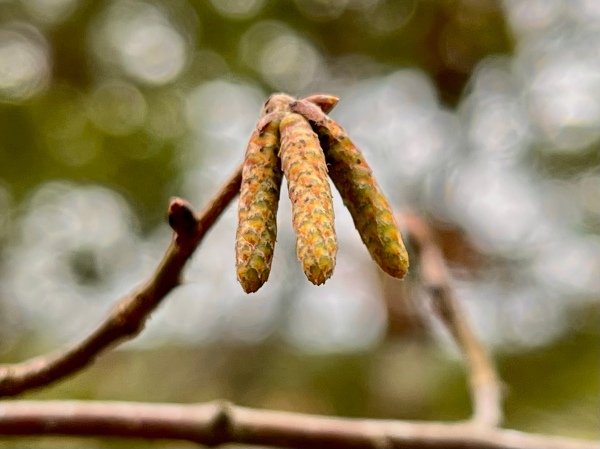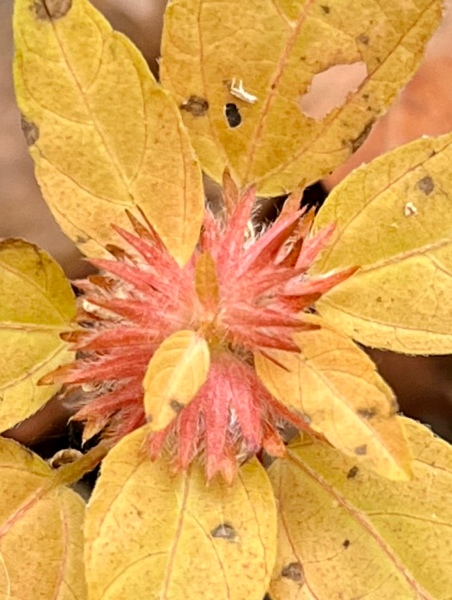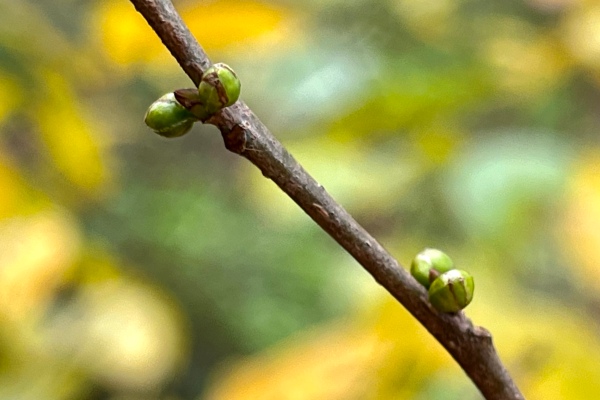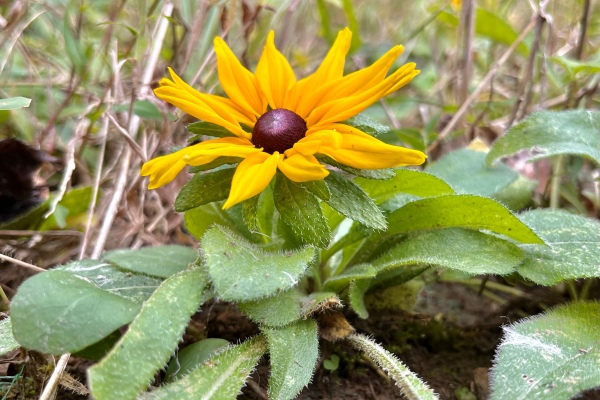Fall color was the goal of today’s Webster Groves Nature Study Society (WGNSS) Botany Group field trip, and Castlewood State Park—with its breathtaking bluff-top views over the Meramec River Valley—is as good a place to see the autumn spectacle as any. It was a well-attended group despite the cool temps, blustery winds, and hint of moisture in the air, likely helped by the park’s closer-than-usual proximity to St. Louis.

The group decided to hike the Lone Wolf Trail, which traverses both dry forest along the bluffs and riparian forest along Kiefer Creek. We got the climbing out of the way quickly by making the long, steep ascent up to the bluffs from the parking lot—giving ample opportunity for all to make it up before exploring the bluffs. John pointed out a small tree with developing male catkins that identified it as Ostrya virginiana (hop hornbeam). The catkins will remain closed through the winter and flower next spring. Ostrya (pronounced “oh-STRY-uh”) bark is usually vertically striate (pronounced “STRY-ate”), but the bark on this tree was still relatively smooth—a “non-striate Ostrya”!

Reaching the wooden deck overlooking the Meramec River Valley, the size of our group apparently intimidated three youngsters that were on the deck, and they quickly yielded way. The expected fall colors had not yet materialized, leading some to engage in what seems to be an annual tradition of debating whether this year’s colors are abnormally late. While at the deck and walking further along the trail from it, debates centered mostly around distinguishing the various oaks and hickories. Fallen (squirrel-clipped?) twigs from one of the large oaks exhibited large, fuzzy, quadrangular buds typical of Quercus velutina (black oak), but the leaves had usually deep sinuses. After consulting a Missouri oaks field guide, we decided they must represent Q. velutina despite the atypical leaves. Close examination of the hickories with magnification revealed distinct pubescence on the buds and petioles, suggesting Carya texana (black hickory).

There was little still remaining in bloom along the bluffs, and what was still in bloom was in pretty rough shape. We found two blue fall asters near each other, but a closer look revealed that they were actually two different species—Symphyotrichum turbinellum (prairie aster), distinguished by its vase-shaped involucre and branchy growth with simple leaves, and Symphyotrichum patens (creeping aster), recognizable at once by its basally clasping leaves. Another fall aster without blooms caused some debate—the recurved phyllaries of the involucre and chordate lower leaves suggested Symphyotrichum anomalum (manyray aster), but the toothed leaf edges suggested something else. Without a flower to see the color, it was suggested it could be an “anomalous anomalum.” Otherwise, only the occasional, scraggly Solidago ulmifolia (elm-leaf goldenrod) completed the list of still-barely-blooming plants along the bluffs.

Descending from the bluffs along a north-facing slope and more mesic conditions provided much more color than along the bluff. Patches of Asimina triloba (pawpaw)—their large, simple leaves now vivid yellow, brightened the understory, while the ubiquitous Acer saccharum (sugar maple) lifted the yellows higher into the canopy. Only the giant oaks, mostly Q. alba (white oak) and the aforementioned Q. velutina soared above the maples, their great height no doubt a result of rich, deep soils on the north-facing slope. On the ground below, a multitude of ferns colonized the moister areas, with three species found growing side-by-side: Adiantum pedatum (northern maidenhair fern), Phegopteris hexagonoptera (broad beech fern), and Polystichum acrostichoides (Christmas fern).

Fall color was not restricted to the leaves of the trees—fruits also provided dazzling points of color. Cornus florida (flowering dogwood) and Lindera benzoin (spicebush) both sported bright red berries similar enough in appearance to each other that close examination was required to distinguish those that had fallen to the ground. The former is synecious (i.e., all flowers bisexual), thus, all individuals can bear fruit. The latter, however, is dioecious (i.e., some individuals bear only male flowers, while others bear only female flowers); thus, only female trees produce the red berries. Comparing male versus female trees provided a chance to compare also the now-developing flower buds that will be among the first to open of any plant next spring. Since male plants tend to flower earlier than females, their flower buds were observed to be ever so slightly larger and further developed than those on female plants.



Along Kiefer Creek, flowers were limited to the occasional Campanula americana (tall bellflower) until we came upon a small area where a few late-blooming and very short-stemmed Rudbeckia hirta (black-eyed Susan) were found (regrowth?), but the remnants of green garden netting found around them indicated that they might have been planted. Definitely native in the same area, however, were a few still-flowering Eupatorium serotinum (late boneset) plants, a couple of which were found to be hosting a small, dark blue and yellow striped caterpillar. Neither of the two entomologists present knew what it was, although both had suggestions, but a little bit of sleuthing revealed them to be the larval stage of Haploa clymene (clymene moth), one of the tiger moths (subfamily Arctiinae) and known to feed on Eupatorium.


After returning to the parking lot and chatting with the group, I went back to the Eupatorium plants to take additional photographs of the Haploa clymene caterpillars with the big camera (look for those in a future post). On the way back to the car, I found a small snail actively crawling over the trail surface—its body fully stretched and antennae fully extended. I couldn’t resist putting the iPhone to the test to see if it could capture good photos of this small snail, and both the lateral and head-on shots were more than adequate. iNaturalist identifies it as a species in the genus Ventridens (dome snail), a member of the family Zonitidae (true glass snails).


©️ Ted C MacRae 2021











